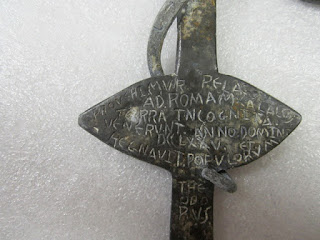Those who read my novel Powdered Gold will recall the controversy over the Tucson lead artifacts discovered in the 1920s. Scott Wolter and other geologists have examined them and concluded that, based on the geology, the artifacts are at least many hundreds of years old, validating their 8th Century AD dating. But some Latin scholars have analyzed the inscriptions and concluded they were lifted from modern Latin textbooks by a hoaxer. Recently an expert on medieval Latin studied the artifacts and has declared them to be genuine:
http://www.theepochtimes.com/n3/2017332-tucson-artifacts-suggest-europeans-made-it-to-new-world-in-8th-century-expert/
In my mind, this pretty much resolves this issue, making these artifacts some of the most important pieces of evidence of early exploration of America.
The Newport Tower

Medieval stone tower ... in Rhode Island. Does it look like any other Colonial structure you've seen? Recent carbon dating of the mortar indicates 1400s construction date (see post below).
The Westford Knight Sword
Medieval Battle Sword ... in Westford, Massachusetts. Can anyone deny the pommel, hilt and blade punch-marked into the bedrock?
The Spirit Pond Rune Stone

Medieval Inscription ... in Maine, near Popham Beach. Long passed off as a hoax, but how many people know the Runic language? And how is it that some of the Runic characters match rare runes on inscriptions found in Minnesota and Rhode Island? Carbon-dating of floorboards at nearby long house date to 1405.
The Narragansett Rune Stone

Medieval Inscription ... in Rhode Island's Narragansett Bay. This Runic inscription is only visible for twenty minutes a day at low tide--is this also the work of a modern-day, Runic-speaking hoaxster?
The Westford Boat Stone

Medieval Ship Carving ... in Westford, MA. Found near the Westford Knight site. Weathering patterns of carving are consistent with that of 600-year-old artifact. And why would a Colonial trail-marker depict a knorr, a 14th-century ship?
The Kensington Rune Stone

Medieval Inscription... in Minnesota. Forensic geology confirms the carvings predate European settlement of Minnesota--so did Runic-speaking Native Americans carve it?
The Hooked X Rune

Medieval Runic Character ... on inscriptions found in Maine, Minnesota and Rhode Island. But this rare rune was only recently found in Europe. This conclusively disproves any hoax theory while also linking these three artifacts together.
Thursday, April 28, 2016
Subscribe to:
Posts (Atom)



